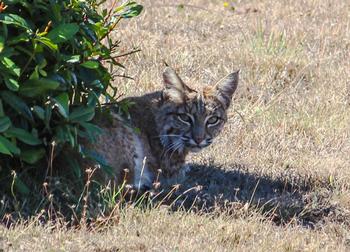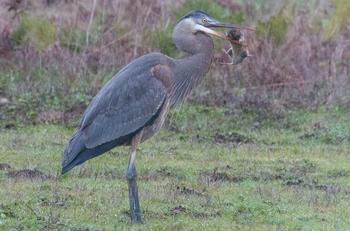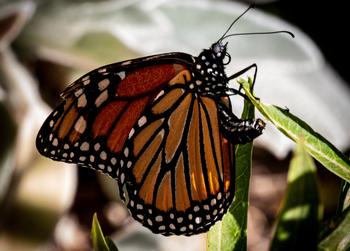Welcome wildlife to your garden
-
Karen Gideon
-
Historically, wildlife has largely been eliminated from gardens by fencing, poison, trapping and starvation. By excluding wildlife from our gardens and fields, we eliminated the beneficial functions performed by pollinators, decomposers, predators and prey. Habitat degradation and our climate crisis are reverberating through the world ecosystem creating a biodiversity imbalance, a die-off of thousands of species, and disruption to the food web.
 Bobcats have a critical role as a predator of mid-sized raccoons and opossums in the ecosystem. Photo: Karen Gideon
Bobcats have a critical role as a predator of mid-sized raccoons and opossums in the ecosystem. Photo: Karen GideonNature’s alarm bell is sounding and gardeners are taking action. The home garden is an inter-connected ecosystem and potential habitat for wildlife, an interface with nature for humans, and a cycle of life and death that produces the very soil beneath our feet. Most of us understand the crisis, know that we are connected to the problem, but translating that to action in our own garden can be a challenge. Here are some ideas to consider in the spirit of habitat restoration and wildlife encouragement.
The food web or pyramid has a critical base of millions of small creatures. These animals – microbes, worms, caterpillars, bugs, slugs and spiders – contribute their labor and serve as food for the next layer of the chain - birds, reptiles, amphibians and snakes. As you move up the food chain, the animals become less abundant and bigger – but they are still reliant on that first layer of small invertebrates. These creatures live in the soil, leaf litter, tree bark – many of the nooks and debris gathering in your garden. Herons, hawks, and owls hunt on land for gophers, moles and other small mammals sometimes considered garden pests. Photo: Karen Gideon
Herons, hawks, and owls hunt on land for gophers, moles and other small mammals sometimes considered garden pests. Photo: Karen GideonWe need to preserve their habitat. If you rake-up your leaves and dispose of them, you remove the resources and nests for many of these tiny creatures, as well as many of the insects and larvae themselves. For fire safety, we must remove the leaves in Zone 0 – the first five feet radiating from structures. But those leaves can be moved and allowed to compost farther from the structures. Make an effort to be less tidy!
Plants from nonindigenous locations are attractive, but they crowd out the native plants that wildlife depends on for food and habitat. Insects, birds and larger animals have evolved and adapted over time. Some become co-dependent on particular native plants. A good example of this is the monarch butterfly. This pollinator uses milkweed as the only food for the hungry caterpillars. For a selection of plants that support our pollinators, see our website at marinmg.ucanr.edu. Click on the “Plants” header and look for “Cal Native Plants.” Monarch butterflies need native milkweed plants to survive. Look closely to see this female laying an egg on the milkweed leaf. Photo: Karen Gideon
Monarch butterflies need native milkweed plants to survive. Look closely to see this female laying an egg on the milkweed leaf. Photo: Karen GideonReduce or eliminate your lawn which acts as a big water sponge and doesn’t contribute to wildlife habitat. Consider adding native grasses, berry bushes and trees to your landscape. Trees provide animal habitats via limbs and leaves as well as a high place to roost for raptors. For ideas check out: https://marinmg.ucanr.edu/BASICS/CONSERVE_WATER_-_ENERGY/Replace_Lawn/.
Avoid using insecticides and pesticides in your home or garden. High density populations of insects and spiders can many times be controlled with benign chemicals. Mosquitos can be held in check by adding a dunk of safe Bacillus thuringiensis to a bucket of water. Beneficial insects can be released to prey on pests. Check out our website at marinmg.ucanr.edu, click on the “PROBLEMS” tab and then “Garden Pests” to learn about controlling wildlife excesses with IPM.
You needn’t open your garden gate to every form of wildlife in Marin. Leave your deer fencing in place if you wish. Build barriers around the foundation and eaves of your home to ward off rats and bats. Bring in your pet’s water and food bowls. Bring the pets in, too, as they can deter wildlife or kill small mammals and birds.
Unfortunately, the biodiversity crisis is huge. However, if each one of us does our small part, we can help move the ecosystem and food web back in balance – enriching our lives and the lives of future generations. And you just might see a beautiful bobcat in your garden.



